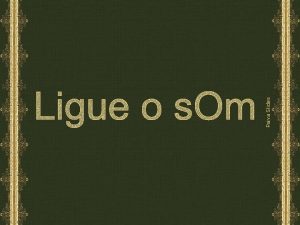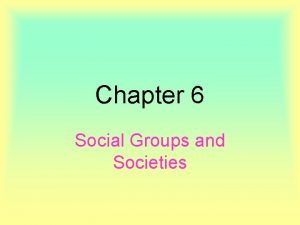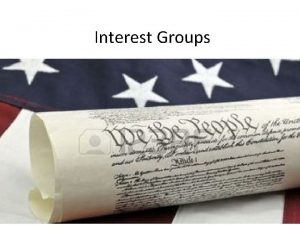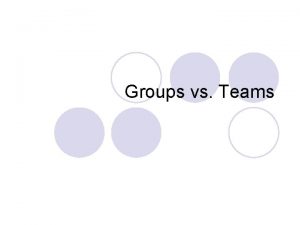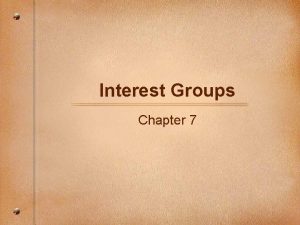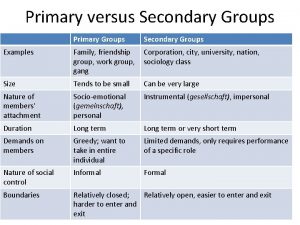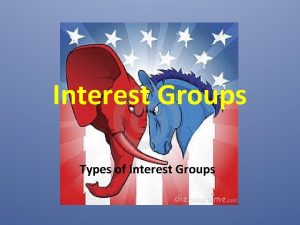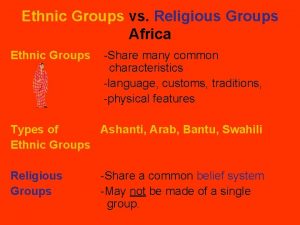CHOOSING IN GROUPS MUNGER AND MUNGER Slides for
























- Slides: 24

CHOOSING IN GROUPS MUNGER AND MUNGER Slides for Chapter 4 The Analytics of Choosing in Groups

Outline of Chapter 4 § Definitions § Preferences, weak orders, and utility functions § Political preferences § Public goods and market failures § Consumer problem § Private goods § Public goods § Lindahl equilibrium § Representation of public preferences § Aggregation problem Slides Produced by Jeremy Spater, Duke University. All rights reserved. 2

Definitions § Preferences: Ordering of all alternatives; ties allowed § Rational if complete and transitive § Utility theory: Use of a mathematical function where utility depends on goods or state of the world § Under certain circumstances, utility can represent preferences § Representation: Mapping of preference profile onto family of utility functions § Binary relation: An ordered triple (X, X, S) in which X is mapped to S § Social choice function: A mapping of >1 preference profiles into a social utility function Slides Produced by Jeremy Spater, Duke University. All rights reserved. 3

Preference § Define a binary relation § “A B” means “A is at least as good as B” from the chooser’s perspective § A and B are both elements of X, the set of alternatives § (strict preference): If A § (strict indifference): If A B then A B but B B and B Slides Produced by Jeremy Spater, Duke University. A A All rights reserved. 4

Preference (2) § Reflexivity: The relation can be applied to one element, A § and are reflexive (A § Symmetry: If A § and B, then B A and A A), but A is not A are not symmetric; is symmetric § Transitivity: § Weak: if A B and B C, then C A § Strong: if A B and B C, then A C § We generally assume , and are transitive for individuals § Completeness: For any A and B in X, A B or B A § Any two alternatives can be compared Slides Produced by Jeremy Spater, Duke University. All rights reserved. 5

Weak order § A weak order is a binary relation that is complete and transitive, defined over a set of alternatives and representing the preferences of a given individual. § We use weak order to represent preferences § Table 4. 2 below corresponds to the ordering A Table 4. 1: General Pattern of Preferences C A ? B A ? C A ? D B ? E C ? D C ? E D ? E A ≂ A B ≂ B C ≂ C D ≂ D E ≂ E Table 4. 2: A ? E B D E B ? C A Possible Set of Preferences A ≻ B A ≻ C A ≻ D A ≻ E B ≻ D B ≻ E C≻ D C ≻ E D ≻ E A ≂ A B ≂ B C ≂ C D ≂ D E ≂ E Slides Produced by Jeremy Spater, Duke University. B ≂ C All rights reserved. 6

Weak order (2) § The preferences in Table 4. 3 correspond to A B C D A § These preferences are not valid, because they are intransitive § Another example of intransitive preferences: A B and B C, but A C Table 4. 3: An Alternative Set of Preferences A ≻ B A ≻ C D ≻ A A ≻ E B ≻ D B ≻ E C≻ D C ≻ E D ≻ E A ≂ A B ≂ B C ≂ C D ≂ D E ≂ E Slides Produced by Jeremy Spater, Duke University. B ≂ C All rights reserved. 7

Utility functions to represent preferences § A function can be said to represent if: § This notion of preferences is valid for considering private goods § Utility function exists, assuming diminishing marginal utility, non-satiety, compactness, and continuity of preferences § We need a different conception for considering public goods (political preferences) Slides Produced by Jeremy Spater, Duke University. All rights reserved. 8

Political preferences § Failure of completeness § Rational ignorance § Self-interested voters have limited incentives to learn about public good § Information is limited and costly § Politicians can mislead § Voters likely don’t know about all possible alternatives § Relationship between candidates and policy outcomes is ambiguous § Completeness is more plausible in committee voting than in mass elections § Failure of non-satiety § It makes sense to assume people always (weakly) prefer more goods § This assumption does not make sense with respect to public goods § “More is better” does not apply, because more services mean more taxes § For ideological issues, “more” does not always have a clear meaning Slides Produced by Jeremy Spater, Duke University. All rights reserved. 9

Public goods § Excludable: How expensive is it to keep someone from using a good? § Rival: Does another person’s use of a good decrease my use of it? § Four types of goods, based on these two dimensions Table 4. 4: Four Types of Goods Excludable Non-excludable Rivalrous Consumption Private Goods Common Pool Resources ( Apples, (Fisheries, Atmosphere) Oranges) Non-Rival Consumption Club Goods Public Goods (Swimming Pools) (National Defense) Slides Produced by Jeremy Spater, Duke University. All rights reserved. 10

Public goods (2) § Political choice: § Who (individual or group) determines supply and allocation of different types of goods? § Sometimes public goods are determined privately, and vice versa § Considerable variation exists among nations § Market failures § Club goods: Acting individually, people supply less than the optimal amount § Common pool goods: “Tragedy of the commons”: resources are overused § Public goods: “Free rider problem”: Individuals prefer to let someone else produce the good Slides Produced by Jeremy Spater, Duke University. All rights reserved. 11

Public goods (3) § Types of Goods, and Types of Choices § Different types of choices are suitable for different types of goods Table 4. 5: Types of Goods, and Types of Choices Type of Good Choice Type: Private Club Commons Public Private Consumer Market Failure: Sovereignty Underprovided Overprovided Underprovided Goods, Too Much Collective Pollution Government Failure: Private Clubs Fix Property Rights Tyranny of the Slides Produced by Jeremy Spater, Duke University. Group All rights reserved. Classic Public Good 12

Consumer problem § Two private goods, Apples (A) and Broccoli (B). Income I § Rewrite with Lagrangian multiplier and take first-order conditions Slides Produced by Jeremy Spater, Duke University. All rights reserved. 13

Consumer problem (2) § Slides Produced by Jeremy Spater, Duke University. All rights reserved. 14

Walrasian auctioneer and equilibrium § The total quantity demanded of each good depends on the prices § “Walrasian auctioneer”: Hypothetical concept to explain markets § “Tatonnement”: Trial and error § Try different prices until total quantity demanded equals total supply available § Auctioneer calls out prices; consumers respond with their supply demanded § If too much is demanded, raise price; if too little, lower price § Iterative process until correct prices are reached § Process is applied to both supply and demand sides of economy § Under certain conditions, equilibrium exists § Resources are allocated from less-valued to more-valued uses Slides Produced by Jeremy Spater, Duke University. All rights reserved. 15

Consumer/citizen problem for public goods § No “tatonnement” process § Public goods are nonrival and nonexcludable § Everyone consumes the same amount § Individual consumption not related to how much each individual pays § Transformation function: § Subject to: Slides Produced by Jeremy Spater, Duke University. All rights reserved. 16

Consumer/citizen problem for public goods (2) § Social welfare function (ui is each citizen’s utility): § Objective function: § Write down Lagrangian: Slides Produced by Jeremy Spater, Duke University. All rights reserved. 17

Consumer/citizen problem for public goods (3) § Take first-order conditions of Lagrangian: Slides Produced by Jeremy Spater, Duke University. All rights reserved. 18

Consumer/citizen problem for public goods (4) § The term is the weight of each individual in the SWF § 1/n is a plausible weight for a democracy. § For a dictatorship, perhaps the dictator’s weight is 1 and everyone else’s is 0. § Individual conditions for private goods ( w/ ui terms cancel!): § Individual conditions for public goods ( w/ ui terms don’t cancel!): Slides Produced by Jeremy Spater, Duke University. All rights reserved. 19

Consumer/citizen problem for public goods (5) § Problems with representing public and private goods in same setting: § Weights of SWF with respect to individuals don’t cancel out! § Group constitution matters § Implied equilibrium levels depend on personal appraisals of the public good § No purely individual component; it depends on personal political beliefs § How do we determine who pays how much? Slides Produced by Jeremy Spater, Duke University. All rights reserved. 20

Lindahl equilibrium § Walrasian auctioneer process for public goods § Announce a level of public goods, and ask citizens what they would pay § If total payments > cost, raise level of public good (or vice versa) § Tatonnement process for public goods Slides Produced by Jeremy Spater, Duke University. All rights reserved. 21

Lindahl equilibrium (2) § Problems with Lindahl equilibrium: § Demand revelation: Everyone under-reports their own willingness to pay § Similar to free rider problem § End up with lower than optimal level of public good § Impossibility theorems (Arrow and others): § There is no solution for a robust and moral SWF that represents public preferences § Public goods preference revelation problem is impossible to solve § Failure of “induced” public sector preferences § Single utility function representing public and private preferences does not exist Slides Produced by Jeremy Spater, Duke University. All rights reserved. 22

Ways to represent public preferences § Use weak ordering directly § This avoids the representation problem entirely § Model collective choice preferences directly § Drop economists’ method of modeling “induced” preferences § Model collective choice rather than public goods § Deal directly with institutions and consequences of choosing in groups § Extension to multiple dimensions Slides Produced by Jeremy Spater, Duke University. All rights reserved. 23

Problem of aggregation § Core of social choice problem: § Aggregation of individual choices into legitimate and accepted consensus § Plott’s fundamental “equation” of politics: § Outcome can change when institutions change (with constant preferences) § Outcome can change when preferences change (with constant institutions) Slides Produced by Jeremy Spater, Duke University. All rights reserved. 24
 Philosophy, politics and economics michael munger
Philosophy, politics and economics michael munger Michael munger duke
Michael munger duke Brian munger
Brian munger How are ethnic groups and religious groups related
How are ethnic groups and religious groups related A small child slides down the four frictionless slides
A small child slides down the four frictionless slides A hockey puck sliding on smooth ice at 4 m/s
A hockey puck sliding on smooth ice at 4 m/s Defining performance and choosing a measurement approach
Defining performance and choosing a measurement approach Defining performance and choosing a measurement approach
Defining performance and choosing a measurement approach Strategi lokasi dan tata letak
Strategi lokasi dan tata letak Choosing and narrowing a topic
Choosing and narrowing a topic Narrowing the topic
Narrowing the topic Fspos
Fspos Novell typiska drag
Novell typiska drag Nationell inriktning för artificiell intelligens
Nationell inriktning för artificiell intelligens Vad står k.r.å.k.a.n för
Vad står k.r.å.k.a.n för Varför kallas perioden 1918-1939 för mellankrigstiden
Varför kallas perioden 1918-1939 för mellankrigstiden En lathund för arbete med kontinuitetshantering
En lathund för arbete med kontinuitetshantering Underlag för särskild löneskatt på pensionskostnader
Underlag för särskild löneskatt på pensionskostnader Personlig tidbok
Personlig tidbok Anatomi organ reproduksi
Anatomi organ reproduksi Förklara densitet för barn
Förklara densitet för barn Datorkunskap för nybörjare
Datorkunskap för nybörjare Boverket ka
Boverket ka Debatt mall
Debatt mall Delegerande ledarskap
Delegerande ledarskap































